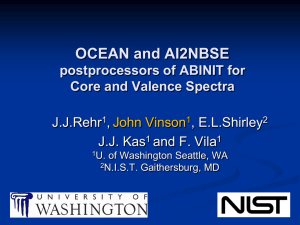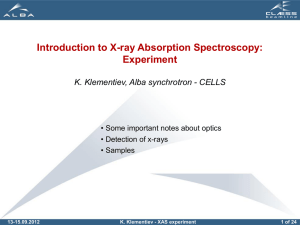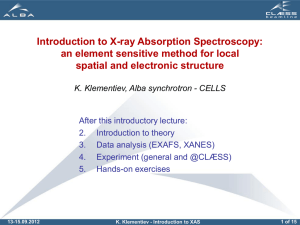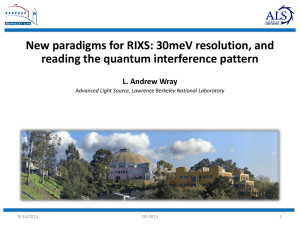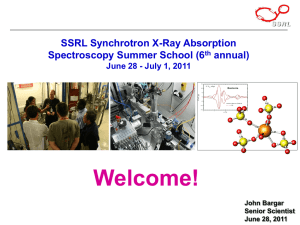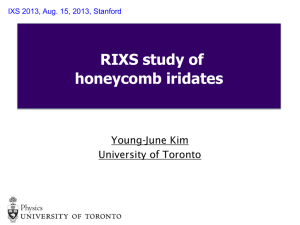lecture note
advertisement
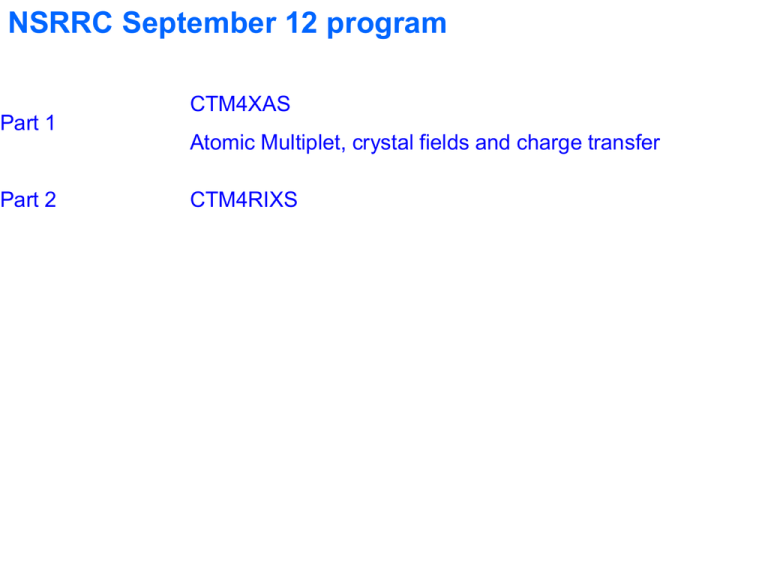
NSRRC September 12 program Part 1 Part 2 CTM4XAS Atomic Multiplet, crystal fields and charge transfer CTM4RIXS Charge Transfer Multiplet program Used for the analysis of XAS, EELS, Photoemission, Auger, XES, ATOMIC PHYSICS GROUP THEORY MODEL HAMILTONIANS X-ray Absorption Spectroscopy Excitations of core electrons to empty states The XAS spectrum is given by the Fermi Golden Rule I XAS ~ f f eˆ r i 2 E f Ei X-ray Absorption Spectroscopy Excitations of core electrons to empty states The XAS spectrum is given by the Fermi Golden Rule 1s I XAS ~ M site ,symmetry 2 X-ray Absorption Spectroscopy 2p 2s Phys. Rev. B.40, 5715 (1989) X-ray Absorption Spectroscopy oxygen 1s > p DOS Phys. Rev. B.40, 5715 (1989); 48, 2074 (1993) X-ray Absorption Spectroscopy oxygen 1s > p DOS Phys. Rev. B.40, 5715 (1989); 48, 2074 (1993) Interpretation of XAS 1-particle: 1s edges (DFT + core hole +U) 2-particle: + all edges of closed shell systems (TDDFT, BSE) many-particle: open shell systems (CTM4XAS) XAS: multiplet effects Fermi Golden Rule: IXAS = |<f|dipole| i>|2 [E=0] f eˆq r i 2 i c eˆq r i ?? eˆq r c 2 Single electron (excitation) approximation: IXAS = |< φ empty|dipole| φcore>|2 2 XAS: multiplet effects Overlap of core and valence wave functions 3d Single Particle model breaks down <2p3d|1/r|2p3d> 2p3/2 2p1/2 Phys. Rev. B. 42, 5459 (1990) X-ray absorption: core hole effect XAS: recent first principles developments for L edges • DFT to cluster Wannier multiplet (Haverkort) • Restricted-Active-Space (Odelius, Koch, Broer, Lundberg) • Extensions of TD-DFT with 2h-2e (Neese, Roemelt) • ab-initio multiplets [‘RAS-DFT’] (Ikeno, Uldry) [ See http://www.anorg.chem.uu.nl/FXS2013/] CTM4XAS (semi-empirical) Charge Transfer Multiplet program Used for the analysis of XAS, EELS, Photoemission, Auger, XES, ATOMIC PHYSICS GROUP THEORY MODEL HAMILTONIANS Atomic Multiplet Theory Atomic Multiplet Theory =E H N pi2 2m N Ze 2 ri pairs e2 rij (ri ) li si N • Kinetic Energy • Nuclear Energy • Electron-electron interaction • Spin-orbit coupling Atomic Multiplet Theory =E H pi2 2m X N N Ze 2 ri X pairs e2 rij (ri ) li si N • Kinetic Energy • Nuclear Energy • Electron-electron interaction • Spin-orbit coupling Term Symbol 2S+1L Term Symbols of a two-electron state 1s2s-configuration Term symbols 1s: 2S Term symbols 2s: 2S Term symbols 1s2s: multiply L and S separately L2p=0, L3p=0 >> LTOT = 0 S2p=1/2, S3p=1/2 Term Symbols 1s2s-configuration S2p=1/2, S3p=1/2 What are the values of the total S (STOT) ? = 0 or 1 Singlet or triplet: ↑↓ or ↑↑, but the degeneracies are 1 and 3 Term Symbols Singlet or triplet Spin-orbit coupling H ATOM pairs e2 rij (ri ) li si N • Couple L and S quantum numbers • L and S loose their exact meaning as quantum numbers • Only the total moment J is a good quantum number Valence Spin-orbit coupling Quantum numbers • Main n 1,2,3,…. • Azimuthal L (orbital moment) • Spin S • Magnetic mL • Spin magnetic mS • Total moment J • Total magnetic mJ (orbital magnetic moment) (spin magnetic moment) Term Symbols • Term symbols of a 2p13d1 configuration • 2p1 2P , 2P 1/2 3/2 (S=1/2, L=1) • 3d1 2D , 2 D 3/2 5/2 (S=1/2, L=2) • 2p13d1 STOT = 0 or 1 LTOT = 1 or 2 or 3 1P1 + 3P0, 3P1, 3P2 1D2 + 3D1, 3D2, 3D3 1F3 + 3F2, 3F3, 3F4 [(2J+1)=3+1+3+5+5+3+5+7+7+5+7+9=60] Term Symbols • Term symbols of a 2p2 configuration Configurations of 2p2 11 00 -1-1 11 00 -1-1 111 000 -1-1-1 11 0 00 -1 -1-1 11 110000-1-1-1-1 11 110000-1-1-1-1 11 1 000 -1-1-1 11 -1-1 11 00 0 -1 1 1 0 0 -1 -1 1 1 0 0 -1 -1 1 1 0 0 -1 -1 Term Symbols of 2p2 MS=1 ML= 2 0 ML= 1 1 ML= 0 1 MS=0 MS=-1 1 0 2 1 3 1 ML=-1 1 2 1 ML=-2 0 1 0 LS term symbols: 1S, 1D, 3P LSJ term symbols: 1S 1D 3P 3P 3P 0 2 0 1 2 The electron-electron interaction H 2 e rij pairs • Electron-electron interaction acts on 2 electrons • It can couple 4 different wave function a, b, c and d The electron-electron interaction 1. Split wave functions into radial and angular part 2. Split operator into radial and angular part 3. Use series expansion of 1/r12 Coulomb integral • Special case: a=c and b=d >> the two electron are in the same shell • Fk is called a Slater integral • It is a number that is calculated from first principles Atomic Multiplet Theory 2 S 1 L f k F gk G e2 2 S 1 J r12 LJ | | k k k Electron-electron interactions of Valence States H ATOM pairs e2 rij (ri ) li si N Valence Spin-orbit coupling k CTM4XAS version 5.2 CTM4XAS version 5.2 Atomic Multiplet Theory 2 S 1 L f k F gk G e2 2 S 1 J r12 LJ | | k k k Core Valence Overlap H ATOM pairs e2 rij (ri ) li si N Core Spin-orbit coupling k Multiplet Effects (Ni2+) 1s 0.07 2s 5 2p 8 3s 3p 13 17 Core Valence Overlap 0 0 17 0 Core Spin-orbit coupling 2 2p XAS of TiO2 • Ground state is 3d0 • Dipole transition 3d02p53d1 • Ground state symmetry: 1S0 • Final state symmetry: 2P2D gives • 1P, 1D, 1F, and 3P, 3D, 3F 2p XAS of TiO2 • Final state symmetries: 1P, 1D, 1F, and 3P, 3D, 3F • Transition <1S0|J=+1| 1P1, 3P1 , 3D1> • 3 peaks in the spectrum Exercise: Calculate the 2p XAS spectrum of a Ti atom Hunds rules • Term symbols with maximum spin S are lowest in energy, • Among these terms: Term symbols with maximum L are lowest in energy • In the presence of spin-orbit coupling, the lowest term has • J = |L-S| if the shell is less than half full • J = L+S if the shell is more than half full 3d1 has 2D3/2 ground state 3d9 has 2D5/2 ground state 3d2 has 3F2 ground state 3d8 has 3F4 ground state Give the Hund’s rule ground states for 3d1 to 3d9 Exercise: Calculate the 2p XAS spectrum of Fe Fe atom: Ground state: 3d6 (4s2) 5D j=4 Term Symbols and XAS Fe atom: Ground state: Final state: Dipole transition: 3d6 (4s2) 2p53d7 p-symmetry 5D, etc. 3d6-configuration: 2p53d7-configuration: 110 states 1P p-transition: ground state symmetry: 5D 5D 1P = 5PDF transition: possible final states: j=4 j’= 3,4, 5 j=+1,0,-1 5D 4 68 states Term Symbols and XAS Fe atom: Ground state: 3d6 (4s2) 5D j=4 5D 0 5D 5D 4 Term Symbols and XAS NiII ion in NiO: Ground state: Final state: Dipole transition: 3d8-configuration: 2p53d9-configuration: p-transition: 3d8 2p53d9 p-symmetry 1S 1D, 3P,1G, 3F , 2P2D = 1,3PDF 1P ground state symmetry: 3F 3F 1P = 3DFG transition: two possible final states: 3D, 3F j=4 j’=0,1,2,3,4 j=+1,0,-1 3F 4 3D ,3F ,3F 1F 3 3 4, 3 3d8 XAS calculation +LS3d : > 3F4 +LS2p 0 +FK, GK: > 3F Atomic multiplets Normalized Intensity 1 0 850 855 860 865 Energy (eV) 870 Charge Transfer Multiplet program ATOMIC PHYSICS GROUP THEORY MODEL HAMILTONIANS Crystal Field Effects eg states t2g states Octahedral crystal field splitting metal ion in free space in symmetrical field in octahedral ligand field eg x2-y2 z2 t2g yz x2-y2 yz z2 xz xy xz xy Crystal Field Effects in CTM 0 7 = 2.13 eV Crystal Field Effects SO3 Oh (Mulliken) S 0 A1 P 1 T1 D 2 E+T2 F 3 A2+T1+T2 G 4 A1+E+T1+T2 2p XAS of TiO2 (atomic multiplets) TiIV ion in TiO2: 3d0-configuration: 2p13d9-configuration: p-transition: 1S , 2P2D 1P Write out all term symbols: 1P 1D 1F 1 2 3 3P 3P 3P 0 1 2 3D 3D 3D 1 2 3 3F 3F 3F 2 3 4 1 3 4 3 1 = 1,3PDF j=0 j’=0,1,2,3,4 j=+1,0,-1 Crystal Field Effect on XAS J in SO3 Deg. 0 1 1 3 2 4 3 3 4 1 12 <1S0|dipole|1P1> goes to <A1|T1|T1> Crystal Field Effect on XAS J in SO3 Deg. Branchings 0 1 A1 1 3 3T1 2 4 4E, 4T2 3 3 3A2, 3T1,3T2 4 1 A1, E, T1, T2 12 <1S0|dipole|1P1> goes to <A1|T1|T1> Crystal Field Effect on XAS J in SO3 Deg. Branchings in Oh Deg. 0 1 A1 A1 2 1 3 3T1 A2 3 2 4 4E, 4T2 T1 7 3 3 3A2, 3T1,3T2 T2 8 4 1 A1, E, T1, T2 E 5 12 <1S0|dipole|1P1> goes to <A1|T1|T1> 25 Effect of 10Dq on XAS:3d0 Comparison with Experiment Comparison with Experiment CTM4XAS version 5.2 CTM4XAS version 5.2 0.0 0.0 0.0 Turning multiplet effects off Hunds rules • Term symbols with maximum spin S are lowest in energy, • Among these terms: Term symbols with maximum L are lowest in energy • In the presence of spin-orbit coupling, the lowest term has • J = |L-S| if the shell is less than half full • J = L+S if the shell is more than half full 3d1 has 2D3/2 ground state 3d9 has 2D5/2 ground state 3d2 has 3F2 ground state 3d8 has 3F4 ground state Crystal Field Effects on 3d8 states Energy Symmetries Oh 1S 4.6 eV 1A 3P 0.2 eV 3T 1 1D -0.1 eV 3F -1.8 eV 1G 0.8 eV 1E 3A 2 1A 1 + 1T2 + 3T1 + 3T2 1T +1T +1E + 1 1 2 Total symmetry Crystal Field Effects SO3 Oh (Butler) Oh (Mulliken) S 0 0 A1 P 1 1 T1 D 2 2 + ^1 E+T2 F 3 ^0+ 1 +^1 A2+T1+T2 G 4 0 + 1 + 2 + ^1 A1+E+T1+T2 Double group symmetry Energy Symmetries Oh 1S 4.6 eV 1A 3P 0.2 eV 3T 1 1D -0.1 eV 3F -1.8 eV 1G 0.8 eV 1E 3A 2 1A 1 Total symmetry A1A1=A1 + 1T2 + 3T1 + 3T2 1T +1T +1E + 1 1 2 T1T2= T1+ T2+ E+ A2 Crystal Field Effects: Tanabe-Sugano Effect of 10Dq on XAS:3dN High-spin or Low-spin 10Dq > 3J (d4 and d5) 10Dq > 2J (d6 and d7) 2p XAS of Mn2+ 3d spin-orbit coupling Exercise: Calculate the 2p XAS spectrum of CoO 3d spin-orbit coupling Charge Transfer Effects Ground state of a transition metal system 3dN at every site Charge fluctations Charge Transfer Effects Hubbard U for a 3d8 ground state: U= E(3d7) + E(3d9) – E(3d8) – E(3d8) Ligand-to-Metal Charge Transfer (LMCT): = E(3d9L) – E(3d8) Charge Transfer Effects = E(3d9L) – E(3d8) E(3d10LL‘) – E(3d8) Two times charge transfer: Extra 3d3d interaction: 2 U 2 +U Charge Transfer Effects Energy (eV) 15 2+U 3U-2 10 5 U- 0 6 7 8 9 10 Charge Transfer Effects in XAS E(3d9L) – E(3d8) = E(3d10LL‘) – E(3d8) = 2 +U 2p XAS: 3d8 2p5 3d9 E (2p53d9) = E2p+ 2p XAS: 3d9L 2p5 3d10L E (2p53d10L) = E2p- Q +2+U Energy difference: E2p- Q +2+U- E2p - = +U-Q Q U+2 eV Charge Transfer Effects in XAS Energy (eV) 15 +U-Q 10 5 0 6 7 8 9 10 Charge Transfer Effects MnO: Ground state: 3d5 + 3d6L Energy of 3d6L: Charge transfer energy 3d5 2p53d6 Charge Transfer Effects MnO: Ground state: 3d5 + 3d6L Energy of 3d6L: Charge transfer energy 3d6L 3d5 2p53d7L +U-Q 2p53d6 Charge Transfer Effects in XPS Energy (eV) 15 10 -Q 5 0 6 7 8 9 10 Charge transfer effects in XAS and XPS • Transition metal oxide: Ground state: 3d5 + 3d6L • Energy of 3d6L: Charge transfer energy 3d6L XPS XAS 2p53d5 3d5 -Q Ground State 2p53d6L 2p53d7L +U-Q 2p53d6 Charge Transfer Effects NiO: Ground state: 3d8 (3d8 ) + 3d9L + 3d93d7 + 3d10L2 + 3d7L Charge transfer energy Hubbard U 2+U Metal-ligand CT MLCT Charge Transfer Multiplets of Ni2+ =3 =9 =0 =6 Exercise: perform a series of charge transfer calculations changing from +10 to -10. X-ray Absorption Spectroscopy Spectral shape: (1) Multiplet effects (2) Charge Transfer J. Elec. Spec. 67, 529 (1994) Charge transfer Charge transfer Charge transfer Charge Transfer effects =10 3d8 + 3d9L 30% 3d8 =5 NiO =0 La2Li½Cu½O4 =-5 1A 1 30% 3d8 3A 2 =-10 Chem. Phys. Lett. 297, 321 (1998) Charge Transfer effects =10 3d8 + 3d9L 30% 3d8 =5 1A 1 NiO =0 La2Li½Cu½O4 30% 3d8 =-5 =-10 Calculate the 2p XAS spectrum of Cs2KCuF6 3A 2 LMCT and MLCT: - bonding FeIII: Ground state: 3d5 + 3d6L M C emptyempty d or p orbital d-orbital 3d6L N filled filled orbital orbital (i) - (i) donation 3d5 C M N filled d-orbital empty *-orbital 2p53d7L (ii) back-donation +U-Q ?C?N distance 5 6 2p 3d with Ed Solomon (Stanford) JACS 125, 12894 (2003), JACS 128, 10442 (2006), JACS 129, 113 (2007) LMCT and MLCT: - bonding FeIII: Ground state: 3d5 + 3d6L + 3d4L 2p53d5L 3d4L -U+Q + 2 3d6L 3d5 2p53d7L +U-Q - 2 2p53d6 with Ed Solomon (Stanford) JACS 125, 12894 (2003), JACS 128, 10442 (2006), JACS 129, 113 (2007) LMCT and MLCT: - bonding FeIII(tacn)2 Normalized Absorption 10 8 Fit X Series2 FeIII(CN)6 6 4 2 0 700 -2 705 710 715 720 725 730 with Ed Solomon (Stanford) JACS 125, 12894 (2003), Energy (eV) JACS 128, 10442 (2006), JACS 129, 113 (2007) RIXS RIXS Butorin, J. Elec. Spec. 110, 213 (2000) Resonant Inelastic X-ray Spectroscopy dd excitation Resonant Inelastic X-ray Spectroscopy 2p XAS of CaF2 3d0 2p53d1 ’ 3s13d1 Resonant Inelastic X-ray Scattering 2p3s RIXS of CaF2 3d0 2p53d1 ’ 3s13d1 Phys. Rev. B. 53, 7099 (1996) Resonant Inelastic X-ray Spectroscopy Butorin J. Elec. Spec 110, 213 (2000) Exercise: Repeat these calculations Soft x-ray RIXS and magnetism NiII 3d8 [] 2p53d9[jj] 3d8[] Soft x-ray RIXS and magnetism S ‘spin-flip’ dd 2p3d RIXS of NiO MS spin-flip Phys. Rev. B. 57, 14584 (1998) CTM4RIXS CTM4RIXS What does the progam do? What does the program do? Nothing, really… no multiplets, no group theory, no angular dependence, …) Takes output of two separate ctm4xas calculations and combines them in Kramers-Heisenberg Formula CTM4RIXS CTM4RIXS • Load in absorption and emission files → Extract information and save energies, symmetries and transition matrix elements (saved as .sm file). • >> These matrices are calculated with CTM4XAS if the RIXS option is chosen Absorption Triad GS → T1 → IS |n>, En W |f>, Ef W |g>, Eg Emission Triad IS → T2 → FS A first CTM4RIXS calculation Choose the name_abs that has been calculated with CTM4XAS A first CTM4RIXS calculation Choose ‘1’ in the pop-up menu A first CTM4RIXS calculation Choose ‘1’ in the pop-up menu A first CTM4RIXS calculation Click button at bottom A first CTM4RIXS calculation Set L intermediate to 0.4 and click button at bottom A first CTM4RIXS calculation Set Delta to 0.1 (two times) and click button at bottom Choose a name in the pop-up window. A first CTM4RIXS calculation Set Delta NOT to a small number >> CTM4RIXS crashes A first CTM4RIXS calculation Start the calculation with the RIXS button A pop-up window tracks the progress. CTM4RIXS • The RIXS calculation is finished. • Next the RIXS plane can be plotted with the screen on the right. Plotting a CTM4RIXS calculation Select the file button and next the select the file you calculated; GOTO the name_RIXS directory GOTO the name_matrices directory SELECT name_Ms Plotting a CTM4RIXS calculation This is the 2p3d RIXS plane of Ni2+ with 10Dq=1.0 eV. Plotting a CTM4RIXS calculation Enlarge a region of the 2D map with this button & select the region. Plotting a CTM4RIXS calculation Final state energy to set the vertical axis to energy loss. (& enlarge/select the region). Selecting a cross-section Choose a vertical cross section & select energy. The screen on the right shows the cross section (= RXES) What is calculated with CTM4RIXS • 2D RIXS plane • Cross sections, including resonant XES selective XAS HERFD partial FY What is NOT calculated with CTM4RIXS • No interatomic exchange (can be included) • Only 3dN > 2p5 3dN+1 > 3dN channel • (as yet) no charge transfer • Fluorescence is not included A first CTM4RIXS calculation Calculations without the CTM4XAS interface Calculations without the CTM4XAS interface Calculation of 2p3d RIXS without charge transfer (note: this is a repetition of CTM4XAS, now with the original DOS commands) 1. Do a CTM4XAS calculation for 2p3d RIXS, for example for Co2+, 10dq=1 eV, using co2 as filename. 2. Copy the files co2_ems.rcg, co2_abs.rcg, co2_ems.rac and co2_abs.rac to the directory c:cowan/batch 3. Open the DOS prompt command window, for type cmd in “search programs” 4. Goto the directory c:/cowan/batch by typing ‘cd ..’, ‘cd ..’, ‘cd cowan’, ‘cd batch’ 5. type ‘rcg2 co2_ems’ and ‘rac2 co2_ems’. Same for the _abs files. 6. Open the ora-files with CTM4RIXS and make a plot (same as with CTM4XAS files) 7. (shift the excitation energy and the emission energy to the correct values) Calculations without the CTM4XAS interface Calculation of 2p3s RIXS (without charge transfer) 1. Do a CTM4XAS calculation for 2p3d RIXS, for example for Co2+, 10dq=1 eV. 2. Do a RCN calculation using hco23s.rcn within c/cowan/batch; The output is written in the file hco23s.rcf 3. Open the file co2p3s_ems.rcg and change the line P_5__D_8 to P_5__D_8__S_2 (keep the same number of spaces indicated by _). Change the line P_6__D_7 to P_6__D_8__S_1. 4. Open the file hco23s.rcf and copy the line starting with “Co2+ 3s01 3d08” and replace in co2p3s_ems the line starting with “Co2+ 2P06 3D07”. 5. Change the energy to 0.0000 (from a value around -600). 6. Re-run the rcg and rac files for 2p3s RIXS. 7. Open the ora-files with CTM4RIXS and make a plot. 8. (shift the excitation energy and the emission energy to the correct values) 9. (Note that the integrated XES spectrum now gives exactly the XAS spectral shape because it is a core-core channel) Calculations without the CTM4XAS interface Calculation of 2p3d RIXS with charge transfer (MATLAB is needed) Step 1: run CTM4XAS • RUN an XAS calculation with CTM4XAS, including charge transfer. • Use any name. I use nitest1, with 10Dq=1, DELTA=3, Udd=6, Upd=7, rest=default. • Copy the files nitest1.rcg and nitest1.ban to cowan/batch • Copy in cowan/batch rni2.rac to nitest1.rac Calculations without the CTM4XAS interface Calculation of 2p3d RIXS with charge transfer (MATLAB is needed) Step 2: Run the calculations for absorption • Copy BANEX2.BAT to cowan/batch #see below# • Copy banderex.exe to cowan/bin ## • Open the DOS prompt • Change the directory to c:cowan/batch • Type Rcg2 nitest1 • Type Rac2 nitest1 • Type Banex2 nitest1 • The result is in the file nitest1.oba (## this is a modified executable file using exact diagonalization as created by Robert Green; ask me to send it to you) Calculations without the CTM4XAS interface Calculation of 2p3d RIXS with charge transfer (MATLAB is needed) Step 3a: Create the inputfiles for the x-ray emission step and run the calculations Copy nitest1.rcg to nitest1x.rcg Edit the file nitest1x.rcg Invert lines 4 and 5 (line 4 is D08 P06) Invert lines 12 and 13 Invert block 4 with block 3. [Each block starts with 0 80998080 Save the file nitest1x.rcg Copy nitest1.rac to nitest1x.rac Copy nitest1.ban to nitest1x.ban …. and ends with -99999999.] Calculations without the CTM4XAS interface Calculation of 2p3d RIXS with charge transfer (MATLAB is needed) Step 3b: Edit the file nitest1x.ban Change the lines def EG2 = 3.000 unity def EF2 = 2.000 unity to def EG2 = 2.000 unity def EF2 = 3.000 unity Change for the triads the first sign from + to – and the last sign from – to + Change erange 0.3 to erange 999 Type Rcg2 nitest1x Type Rac2 nitest1x Type Banex2 nitest1x The result is in the file nitest1x.oba Calculations without the CTM4XAS interface Calculation of 2p3d RIXS with charge transfer (MATLAB is needed) Step 4: Run the Kramers-Heisenberg calculation (for the moment use this procedure; all parameters are set in racin.m) • Copy nitest1.oba to rni2.oba • Copy nitest1x.oba to rni2x.oba • Start MATLAB • Type dorixs • The RIXS matrix is saved in rni2_MS • Change the name rni2_MS to rni2_MS.mat Step 5: Plot with CTM4RIXS Load the file rni2_Ms.mat XES calculations X-ray absorption and X-ray photoemission Core Hole Decay Fluorescence Auger 3 / 2 2 p 1 / 2 2 p 2 s 1 s 3 / 2 2 p 1 / 2 2 p 2 s f l u o r e s c e n t r a d i a t i o n 1 s X-ray emission Resonant X-ray emission spectroscopy 1s X-ray emission MnO K Main Lines K Satellite Lines K1,3 K2,5 K'' K1 x 500 K2 K' x8 K 5880 5900 5920 6480 6520 Fluorescence Energy [eV] 6560 1s X-ray emission K Main Lines K Satellite Lines K1,3 K2,5 K'' x 500 K2 K' x8 K K 5880 1s13dn 5900 5920 6480 6520 6560 K Main Lines K Satellites Fluorescence Energy [eV] 2p53dn Photoionization or K capture 3p53dn Core Hole Valence hole Ground State 3dn Total Energy K1 Multiplet effects in 1s3p XES (Kβ) Etotal 3d 1s K Fluorescence Photoionization 3d 3p Strong interaction between unfilled 3p and 3d shells! Multiplet effects in 1s3p Spin-selectivity inXES the (Kβ) K line 7P 3d 3p 5P ? 3d 3p K’ K1,3 3p XPS and K XES Multiplet effects in 1s3p XES (Kβ) Identical final state configuration: 3p53d5 A MnF2 K F B Free Mn atom 3p XPS 1s2p and 1s3p XES spectra 1s2p and 1s3p XES spectra Approximations: - 3dN ground state (+ CT) - XES only from lowest energy 1s13dN state (+CT) - Charge transfer energy is -Q Charge transfer in 1s pre-edge and edge • Transition metal oxide: Ground state: 3d5 + 3d6L • Energy of 3d6L: Charge transfer energy 3d6L edge Pre-edge 1s13d5 3d5 -Q Ground State 1s13d6L 1s13d7L +U-Q 1s13d6 1s2p and 1s3p XES spectra Approximations: - 3dN ground state (+ CT) - XES only from lowest energy 1s13dN state (+CT) - Charge transfer energy is -Q - Neglect 1s3d exchange interaction (needed for spin-pol.) - Neglect of excitation process (a better approximation is to describe the excitation process with XPS) Charge transfer in XES spectra Pieter Glatzel et al. Phys. Rev. B. 64, 045109 (2001) Charge transfer in XES spectra Pieter Glatzel et al. Phys. Rev. B. 64, 045109 (2001) RIXS at metal K edges Fe K pre-edges Exercise: Repeat these calculations Westre et al. JACS 119, 6297 (1997); Heyboer et al. J.Phys.Chem.B. 108, 10002 (2004) Exercise: Repeat these calculations CoO Pre-edge and edge high-spin CoII 3d7 [4T2] Only quadrupole peaks visible 3d7 1s13d8 2p53d8 Only correct with interference effects ON Non-local peaks RIXS-MCD screening at the K pre-edge Non-local peaks RIXS-MCD screening at the K pre-edge Non-local peaks RIXS-MCD screening at the K pre-edge Non-local screening peaks RIXS-MCD at the K pre-edge of Fe3O4 Non-local peaks RIXS-MCD screening at the K pre-edge Non-local peaks RIXS-MCD screening at the K pre-edge XMCD at high-pressure Sikora, PRL 105, 037202 (2010) MCD X-MCD X-MCD Cu2+: 3d9 L=2, S=1/2 2D J=5/2 or 3/2 More than half-full 2D5/2 2p53d10 L=1, S=1/2 2P J=3/2 or 1/2 2P3/2 or 2P1/2 J= +1 or 0 or -1 light polarization q = mJ X-MCD Cu2+: 3d9 X-MCD MCD mJ=-5/2 to mJ’=-3/2 MCD no LS Exercise: Repeat these calculations X-MCD MCD no LS MCD + crystal field X-MCD MCD 3F 4 3F LS no LS XPS X-ray photoemission Charge transfer effects in XPS Charge Transfer Effects in XAS Energy (eV) 15 +U-Q 10 5 0 6 7 8 9 10 Charge Transfer Effects MnO: Ground state: 3d5 + 3d6L Energy of 3d6L: Charge transfer energy 3d5 2p53d6 Charge Transfer Effects MnO: Ground state: 3d5 + 3d6L Energy of 3d6L: Charge transfer energy 3d6L 3d5 2p53d7L +U-Q 2p53d6 Charge Transfer Effects in XPS Energy (eV) 15 10 -Q 5 0 6 7 8 9 10 Charge transfer effects in XAS and XPS • Transition metal oxide: Ground state: 3d5 + 3d6L • Energy of 3d6L: Charge transfer energy 3d6L XPS XAS 2p53d5 3d5 -Q Ground State 2p53d6L 2p53d7L +U-Q 2p53d6 Charge transfer effects in XPS Exercise: Calculate the 2p XPS spectrum of NiCl2
